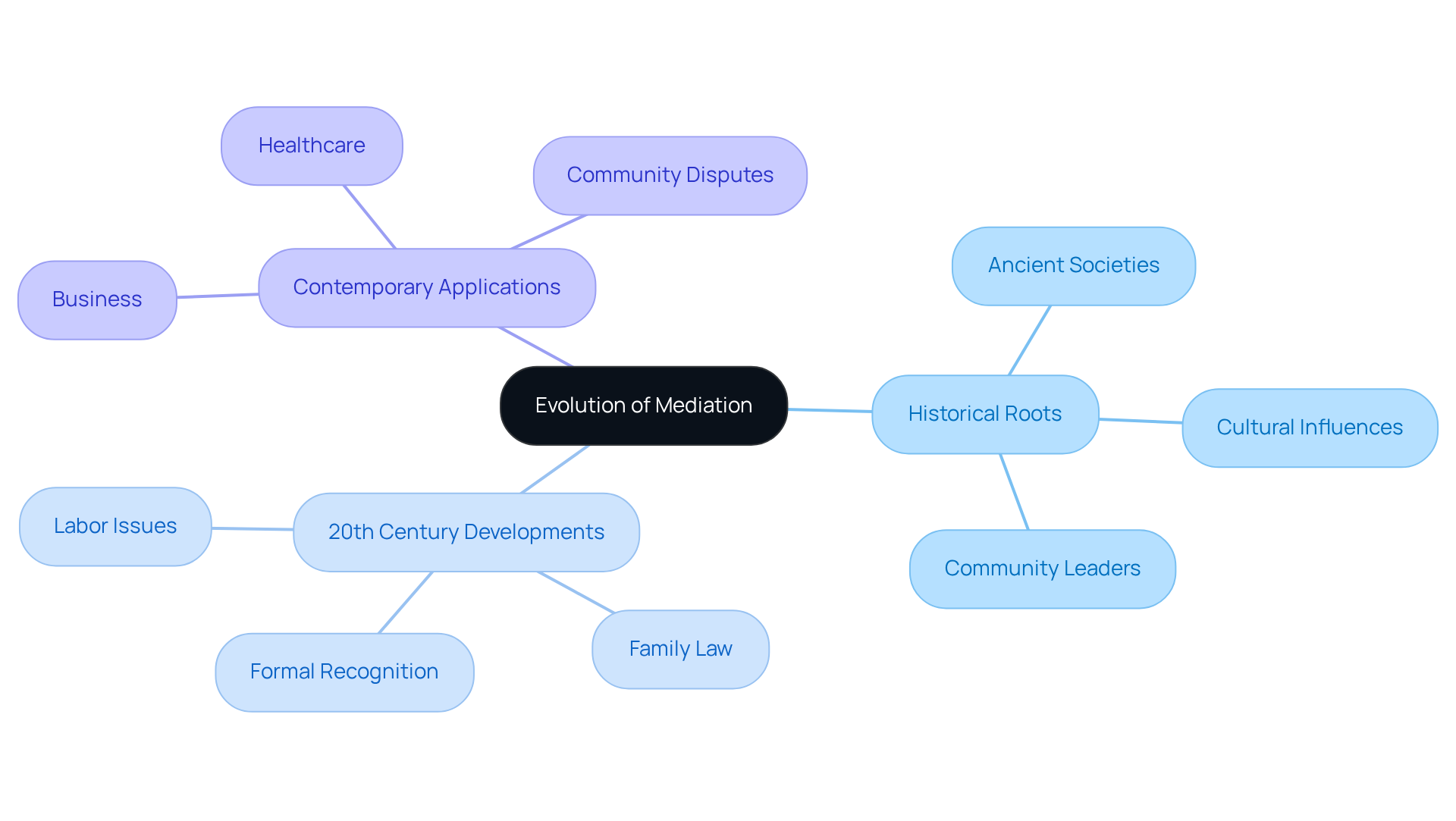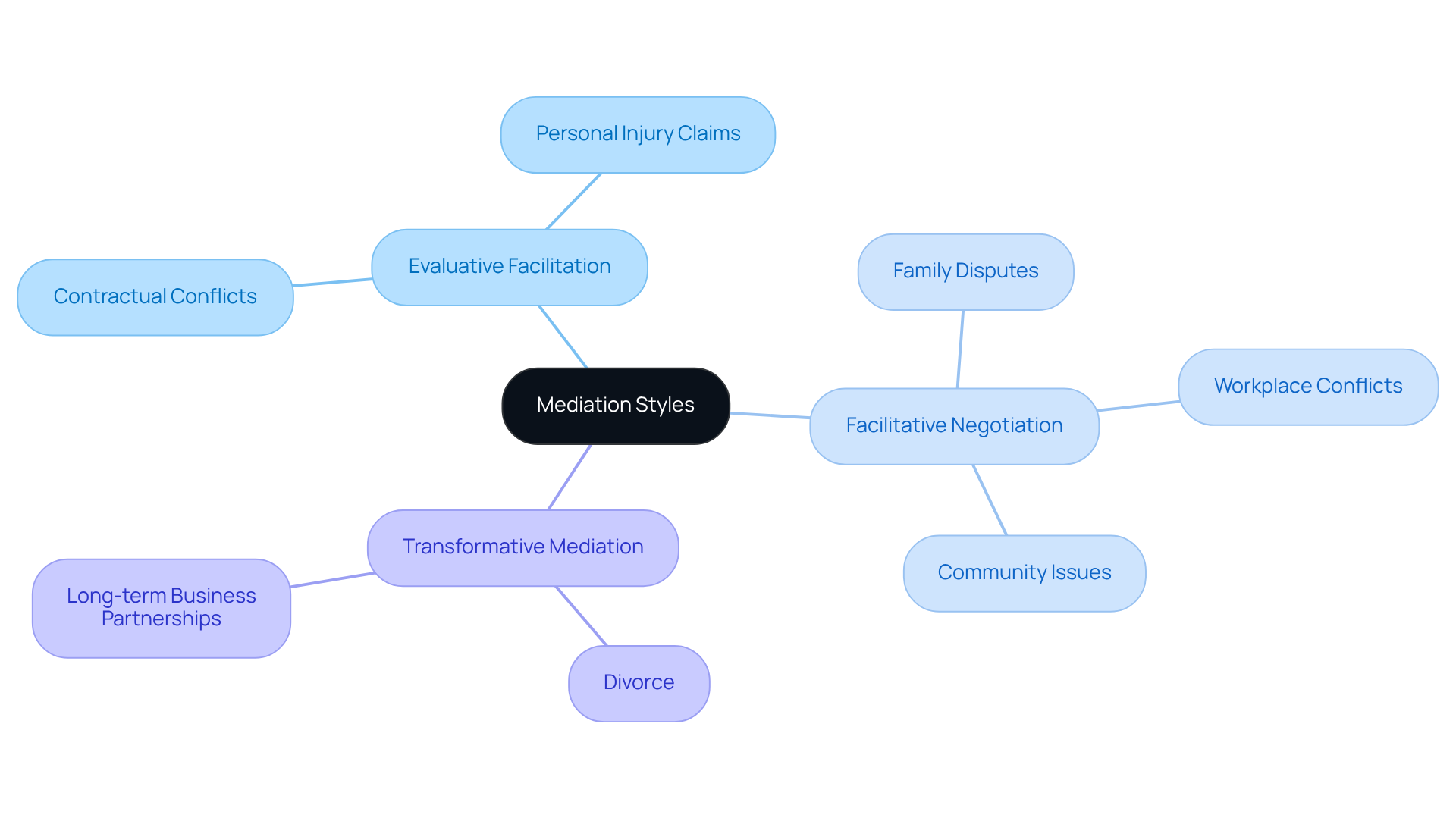
Understanding the Styles of Mediation: Key Characteristics and Applications
Overview
This article explores the various styles of mediation—evaluative, facilitative, and transformative—and how they can effectively address conflicts. Have you ever felt overwhelmed by a disagreement? Understanding these mediation styles can help you navigate those challenging situations more smoothly. Each style serves a unique purpose, catering to different circumstances and relationships.
Choosing the right approach is crucial. It not only impacts the outcome of the mediation but also fosters better communication and understanding among all parties involved. Imagine the relief of resolving a conflict with clarity and compassion.
As you consider your own experiences, remember that the right mediation style can make a significant difference. By acknowledging the nature of the conflict and the relationships at play, you can create a more supportive environment for resolution. We encourage you to reflect on which style resonates most with you and how it might help in your future interactions.
Introduction
Mediation serves as a vital tool in resolving conflicts, yet many of us may feel uncertain about the various styles available to meet our specific needs. By exploring the key characteristics and applications of different mediation approaches, we can unlock the potential for more effective and harmonious resolutions together.
But with so many styles to choose from—evaluative, facilitative, and transformative—how can you determine the best fit for your unique situation? Understanding these distinctions is essential for navigating conflicts with empathy and precision.
Imagine how empowering it would be to approach conflicts with clarity and confidence. Let's take this journey together, exploring the pathways to resolution that can foster understanding and connection.
Define Mediation: Understanding the Core Concept
Mediation involves different styles of mediation where a neutral third individual, known as a facilitator, helps conflicting groups find a resolution that works for everyone. Have you ever felt overwhelmed by a disagreement? Unlike a judge or arbitrator, the mediator uses various styles of mediation instead of imposing a decision; they facilitate dialogue, guiding you to explore your interests and options. This cooperative method is one of the styles of mediation designed to help you settle your disagreements peacefully, making facilitation a favored choice for those seeking efficient and effective conflict resolution.
The essence of conflict resolution is embodied in communication, understanding, and the different styles of mediation. These elements are crucial for achieving lasting solutions. Imagine a space where your voice is heard, and your concerns are addressed. Mediation creates that space, allowing you to express your feelings and work towards a shared understanding.
Key Benefits of Mediation:
- Empowers you to take control of the outcome.
- Encourages open communication and understanding.
- Fosters a collaborative environment.
Isn’t it comforting to know that there’s a supportive process available? By choosing mediation, you’re not just resolving a conflict; you’re building a foundation for better relationships and future interactions. Let’s embrace this journey together, focusing on healing and understanding.

Trace the Evolution of Mediation: Historical Context and Importance
Mediation has deep roots in our shared history, tracing back to ancient societies where community leaders often stepped in as mediators to resolve conflicts. Can you imagine how much understanding and compassion was needed in those moments? Over time, this practice has evolved into different styles of mediation, shaped by cultural, legal, and social changes that reflect our growing awareness of the importance of peaceful resolution.
In the 20th century, conflict resolution began to gain formal recognition as a valuable alternative to litigation, particularly in the United States. It became a cornerstone in family law and labor issues, highlighting our collective desire for more harmonious solutions. The beauty of negotiation lies in its ability to offer a less confrontational and more cooperative approach to disputes. It nurtures relationships and preserves the dignity of everyone involved.
Today, we see styles of mediation embraced across various sectors—be it in business, healthcare, or community disputes. This widespread acknowledgment speaks volumes about its adaptability and effectiveness. Have you considered how mediation could transform your own experiences with conflict? By choosing this path, you not only foster understanding but also create opportunities for lasting connections and resolutions that honor everyone’s voice.

Explore the Main Styles of Mediation: Evaluative, Facilitative, and Transformative
There are three main styles of mediation in conflict resolution: evaluative, facilitative, and transformative. Each of these approaches offers unique benefits that can help individuals navigate their challenges with care and understanding.
-
Evaluative facilitation involves the facilitator providing evaluations and suggestions based on their expertise. This method often guides participants toward a resolution, making it particularly beneficial in legal conflicts where a swift resolution is desired. Have you ever felt the pressure to resolve a situation quickly? This approach can alleviate some of that stress.
-
On the other hand, facilitative negotiation focuses on improving communication among those involved. It allows individuals to express their needs and interests without direct involvement from the mediator. This method shines in conflicts where relationships are important, such as family or workplace situations. Can you recall a time when open communication made a difference?
-
Lastly, transformative conflict resolution aims to change the dynamics of the relationship between individuals, fostering understanding and empathy. This style is especially valuable when long-term relationships are at stake, as it encourages personal growth and mutual respect. Imagine the positive outcomes that can arise when we prioritize empathy in our interactions.
By considering the styles of mediation, we can approach conflict resolution with a sense of compassion and support, paving the way for healthier relationships.

Identify Practical Applications: When to Use Each Mediation Style
Choosing the right negotiation approach is deeply influenced by the nature of the conflict and the relationships between those involved. Have you ever found yourself in a situation where a swift resolution is necessary? Evaluative facilitation can be a wonderful choice in such cases, especially in contractual conflicts or personal injury claims. Here, the mediator’s expertise can truly benefit everyone involved.
On the other hand, when it comes to family disputes, workplace conflicts, or community issues, facilitative negotiation shines. In these instances, open communication becomes essential for understanding and finding resolution. It’s about creating a space where everyone feels heard and valued.
For situations that involve deep-seated emotional issues, such as divorce or long-term business partnerships, transformative mediation proves particularly effective. Rebuilding trust and respect in these contexts is crucial, and this approach can guide the parties toward healing.
By recognizing the strengths and applications of each style of mediation, we can thoughtfully select the most effective approach to resolve conflicts. Remember, it’s about finding a path that not only addresses the issues at hand but also nurtures the relationships involved.

Conclusion
Mediation serves as a vital tool in conflict resolution, offering various styles that cater to different needs and circumstances. By facilitating communication and understanding among conflicting parties, mediation empowers us to take charge of our disputes, fostering a collaborative environment where solutions can be reached amicably. This approach not only addresses immediate issues but also lays the groundwork for healthier relationships moving forward.
As we reflect on the evolution of mediation, we can appreciate its historical significance and adaptability across diverse sectors. From the ancient practices of community leaders to modern-day applications in family law and business disputes, mediation has proven its effectiveness. The exploration of evaluative, facilitative, and transformative styles highlights how each method can uniquely address specific conflict scenarios. Whether our goal is to achieve a swift resolution, enhance communication, or rebuild trust, there’s a mediation style that can help.
Recognizing the importance of mediation, we see that choosing the right approach can transform conflict into an opportunity for growth and understanding. Embracing mediation not only provides a pathway to resolution but also cultivates a culture of empathy and respect. As we navigate our conflicts, applying these mediation styles can lead to more harmonious interactions and lasting connections.
Let’s take the step towards a more peaceful future together. How can we embrace mediation in our lives? By doing so, we open the door to understanding and collaboration, enriching our relationships and fostering a supportive community.
Frequently Asked Questions
What is mediation?
Mediation is a process where a neutral third party, known as a facilitator, helps conflicting groups find a resolution that works for everyone. Unlike a judge or arbitrator, the mediator facilitates dialogue and guides the parties to explore their interests and options.
How does mediation differ from arbitration or court decisions?
Mediation differs from arbitration or court decisions in that it does not impose a decision. Instead, it encourages open communication and collaboration among the parties involved, allowing them to reach a mutually agreeable solution.
What are the key benefits of mediation?
The key benefits of mediation include empowering individuals to take control of the outcome, encouraging open communication and understanding, and fostering a collaborative environment.
How does mediation create a supportive environment?
Mediation creates a supportive environment by allowing individuals to express their feelings and concerns, facilitating a space where their voices are heard and addressing their issues, which helps in working towards a shared understanding.
What is the essence of conflict resolution in mediation?
The essence of conflict resolution in mediation is embodied in communication, understanding, and the various styles of mediation, which are crucial for achieving lasting solutions.


